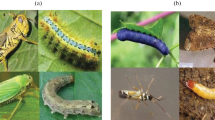Abstract
Crops are attacked by a variety of pests and diseases during their growth. Different pests have different control measures, and being able to accurately identify pests has become the key to pest control. Traditional methods have relatively low accuracy in pest identification due to the complexity of their algorithms and their susceptibility to environmental interference. This paper proposes an end-to-end pest identification network that combines deep learning and hyperspectral imaging technology. This method can identify common pests for the purposes of effective pest control. Noise and redundant information in the hyperspectral image (HSI) spectral space are treated by one-dimensional convolution and the attention mechanism between spectral channels to design a spectral feature extraction module for the efficient use of spectral information. The three-dimensional convolution branch structure of different resolutions in parallel is used as the HSI feature extractor to secure rich spectral–spatial information. The output feature map maintains high resolution throughout its usage. To further enhance the feature extraction capabilities of the network, an adaptive spectral–spatial feature extraction module is inserted into each branch to dynamically weight different information, thereby reducing the HSI’s undue influence. A hyperspectral imaging system was used to collect pest HSI, and a dataset containing nine kinds of common pests was constructed accordingly. The above method is used to test on this dataset, and the experimental results prove that this method has higher pest identification accuracy and is more suitable for pest identification tasks than other methods.






Similar content being viewed by others
References
Strange, R.N., Scott, P.R.: Plant disease: a threat to global food security. Ann. Rev. Phytopathol. 43(1), 83–116 (2005). https://doi.org/10.1146/anurev.phyto.43.113004.133839
Gowen, A.A., O’Donnell, C.P., Cullen, P.J., Downey, G., Frias, J.M.: Hyperspectral imaging—an emerging process analytical tool for food quality and safety control. Trends Food Sci. Technol. 18(12), 590–598 (2007). https://doi.org/10.1016/j.tifs.2007.06.001
Du, Q.D., Zhang, L.Z., Zhang, B.Z., Tong, X.T., Chanussot, J.C.: Foreword to the special issue on hyperspectral remote sensing: theory, methods, and applications. IEEE J. Sel. Topics Appl. Earth Observ. Remote Sens. 6(2), 459–465 (2013). https://doi.org/10.1109/JSTARS.2013.2257422
Zhu, H., Chu, B., Zhang, C., Liu, F., Jiang, L., He, Y.: Hyperspectral imaging for presymptomatic detection of tobacco disease with successive projections algorithm and machine-learning classifiers. Sci. Rep. 7(1), 4125 (2017). https://doi.org/10.1038/s41598-017-04501-2
Liu, Z.Y., Qi, J.G., Wang, N.N., Zhu, Z.R., Luo, J., Liu, L.J.: Hyperspectral discrimination of foliar biotic damages in rice using principal component analysis and probabilistic neural network. Precis. Agric. 19, 973–991 (2018). https://doi.org/10.1007/s11119-018-9567-4
Nagasubramanian, K., Jones, S., Singh, A.K., Sarkar, S., Singh, A., Ganapathysubramanian, B.: Plant disease identification using explainable 3d deep learning on hyperspectral images. Plant Methods 15(1), 98 (2019). https://doi.org/10.1186/s13007-019-0479-8
Zhao, J., Fang, Y., Chu, G., Yan, H., Hu, L., Huang, L.: Identification of leaf-scale wheat powdery mildew (blumeria graminis f. sp. tritici) combining hyperspectral imaging and an SVM classifier. Plants 9(8), 936 (2020). https://doi.org/10.3390/plants9080936
Hughes, G.: On the mean accuracy of statistical pattern recognizers. IEEE Trans. Inf. Theory 14(1), 55–63 (2003). https://doi.org/10.1109/TIT.1968.1054102
Samat, A., Li, J., Liu, S., Du, P., Miao, Z., Luo, J.: Improved hyperspectral image classification by active learning using pre-designed mixed pixels. Pattern Recognit. 51(C), 43–58 (2016). https://doi.org/10.1016/j.patcog.2015.08.019
Chen, Y., Lin, Z., Xing, Z., Gang, W., Gu, Y.: Deep learning-based classification of hyperspectral data. IEEE J. Sel. Topics Appl. Earth Observ. Remote Sens. 7(6), 2094–2107 (2017). https://doi.org/10.1109/JSTARS.2014.2329330
Li, Y., Xie, W., Li, H.: Hyperspectral image reconstruction by deep convolutional neural network for classification. Pattern Recogn. 63, 371–383 (2017). https://doi.org/10.1016/j.patcog.2016.10.019
Li, J., Zhao, X., Li, Y., Du, Q., Xi, B., Hu, J.: Classification of hyperspectral imagery using a new fully convolutional neural network. IEEEGeosci. Remote Sens. Lett. 15(2), 292–296 (2018). https://doi.org/10.1109/LGRS.2017.2786272
Tran, D., Bourdev, L., Fergus, R., Torresani, L., Paluri, M.: Learning spatiotemporal features with 3D convolutional networks. In: IEEE International Conference on Computer Vision (ICCV). pp. 4489–4497(2051). https://doi.org/10.1109/ICCV.2015.510
Audebert, N., Saux, B.L., Lefèvre, S.: Deep learning for classification of hyperspectral data: a comparative review. IEEE Geosci. Remote Sens. Mag. 7(2), 159–173 (2019). https://doi.org/10.1109/MGRS.2019.2912563
Zhang, H., Li, Y., Zhang, Y., Shen, Q.: Spectral-spatial classification of hyperspectral imagery using a dual-channel convolutional neural network. Remote Sens. Lett. 8(4–6), 438–447 (2017). https://doi.org/10.1080/2150704X.2017.1280200
Chen, Y., Jiang, H., Li, C., Jia, X., Ghamisi, P.: Deep feature extraction and classification of hyperspectral images based on convolutional neural networks. IEEE Trans. Geosci. Remote Sens. 54(10), 6232–6251 (2016). https://doi.org/10.1109/TGRS.2016.2584107
Roy, S.K., Krishna, G., Dubey, S.R., Chaudhuri, B.B.: Hybridsn: exploring 3d–2d CNN feature hierarchy for hyperspectral image classification. IEEE Geosci. Remote Sens. Lett. 17(2), 277–281 (2020). https://doi.org/10.1109/LGRS.2019.2918719
Zhong, Z., Li, J., Luo, Z., Chapman, M.: Spectral-spatial residual network for hyperspectral image classification: a 3-d deep learning framework. IEEE Trans. Geosci. Remote Sens. 56(2), 847–858 (2017). https://doi.org/10.1109/TGRS.2017.2755542
Acknowledgements
This work was supported by the Program for Innovative Research Team in University of Tianjin (No. TD13-5034) and the Natural Science Foundation of Tianjin City (No. 18JCYBJC15300).
Author information
Authors and Affiliations
Corresponding author
Additional information
Publisher's Note
Springer Nature remains neutral with regard to jurisdictional claims in published maps and institutional affiliations.
Rights and permissions
About this article
Cite this article
Xiao, Z., Yin, K., Geng, L. et al. Pest identification via hyperspectral image and deep learning. SIViP 16, 873–880 (2022). https://doi.org/10.1007/s11760-021-02029-7
Received:
Revised:
Accepted:
Published:
Issue Date:
DOI: https://doi.org/10.1007/s11760-021-02029-7




